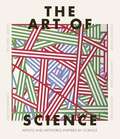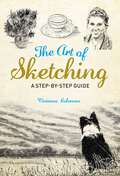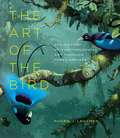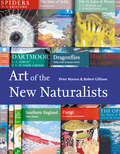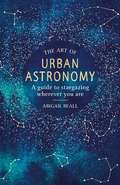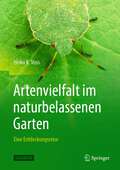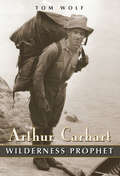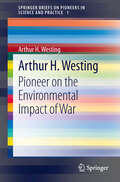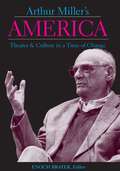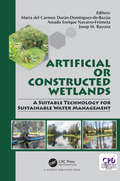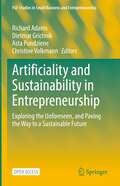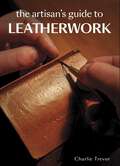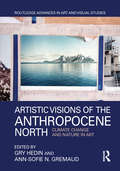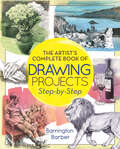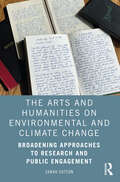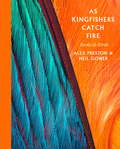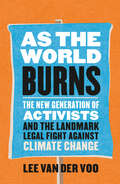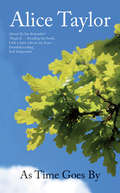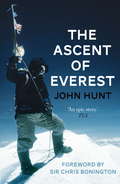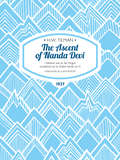- Table View
- List View
The Art of Science: Artists and artworks inspired by science
by Heather Barnett Richard J BrightArt and science – they may seem like opposites, but throughout history there have been visionaries who have brought together these contrasting subjects.The Art of Science explores the work of 40 such artists and artist-scientists, uncovering how these innovators have designed futuristic technology centuries ahead of its time, investigated time and space through abstract art, and created sculpture informed by NASA technology.An expertly curated selection of artists from many different cultures and eras – including Huang Quan, Leonardo da Vinci, Johannes Vermeer, Anna Atkins, Olafur Eliasson and Anicka Yi – this book tells the story of the vital partnership between art and science, with over 200 lavish illustrations.
The Art of Sketching: A Step by Step Guide
by Vivienne ColemanSketching is a wonderful pastime and a great way to build up your drawing skills. You can use it to record your experiences and subjects that interest you, just by jotting down an impression in your sketchbook. In this inspiring manual, artist Vivienne Coleman guides you through a variety of subjects in easy, confidence-building steps. She shows you how to do complete drawings in just a few minutes, so that you can make sketching part of your daily life. She also demonstrates how sketches can be developed into more detailed work. From pets and people to landscape and urban scenes, this book reveals how versatile and exciting sketching can be. It features:• ten-minute sketch ideas• essential drawing techniques• sketching at home and on the move• step-by-step instruction
The Art of the Bird: The History of Ornithological Art through Forty Artists
by Roger J. LedererThe human history of depicting birds dates to as many as 40,000 years ago, when Paleolithic artists took to cave walls to capture winged and other beasts. But the art form has reached its peak in the last four hundred years. In The Art of the Bird, devout birder and ornithologist Roger J. Lederer celebrates this heyday of avian illustration in forty artists’ profiles, beginning with the work of Flemish painter Frans Snyders in the early 1600s and continuing through to contemporary artists like Elizabeth Butterworth, famed for her portraits of macaws. Stretching its wings across time, taxa, geography, and artistic style—from the celebrated realism of American conservation icon John James Audubon, to Elizabeth Gould’s nineteenth-century renderings of museum specimens from the Himalayas, to Swedish artist and ornithologist Lars Jonsson’s ethereal watercolors—this book is feathered with art and artists as diverse and beautiful as their subjects. A soaring exploration of our fascination with the avian form, The Art of the Bird is a testament to the ways in which the intense observation inherent in both art and science reveals the mysteries of the natural world.
The Art of the Bird: The History of Ornithological Art through Forty Artists
by Roger J. LedererThe human history of depicting birds dates to as many as 40,000 years ago, when Paleolithic artists took to cave walls to capture winged and other beasts. But the art form has reached its peak in the last four hundred years. In The Art of the Bird, devout birder and ornithologist Roger J. Lederer celebrates this heyday of avian illustration in forty artists’ profiles, beginning with the work of Flemish painter Frans Snyders in the early 1600s and continuing through to contemporary artists like Elizabeth Butterworth, famed for her portraits of macaws. Stretching its wings across time, taxa, geography, and artistic style—from the celebrated realism of American conservation icon John James Audubon, to Elizabeth Gould’s nineteenth-century renderings of museum specimens from the Himalayas, to Swedish artist and ornithologist Lars Jonsson’s ethereal watercolors—this book is feathered with art and artists as diverse and beautiful as their subjects. A soaring exploration of our fascination with the avian form, The Art of the Bird is a testament to the ways in which the intense observation inherent in both art and science reveals the mysteries of the natural world.
Art of the New Naturalists: A Complete History
by Peter Marren Robert GillmorThe stunning, specially commissioned cover illustrations are one of the great joys of the New Naturalist series, lending it a distinctive style which has inspired nature enthusiasts for many decades.
The Art of Urban Astronomy: A Guide to Stargazing Wherever You Are
by Abigail BeallDid you know that stars are seasonal? That Orion is one of the brightest constellations? That a single day on Venus is longer than an entire year on Venus? Space has captivated mankind since the beginning of time. Fifty years ago, Neil Armstrong became the first man to step on the moon and since then our knowledge of astronomy has continued to expand. With so many mysteries yet to be solved, science journalist Abigail Beall takes readers on an astonishing journey though the landscape of space. In The Art of Urban Astronomy, you will be guided through the seasons and learn about the brightest stars and constellations, the myths and legends of astronomy and how to identify star clusters and galaxies with just your eyes or a pair of binoculars. For urban dwellers wrapped up in the rush and bustle of the city, it can be calming and truly valuable to take the time simply to stop, look and reconnect with nature. Packed full of seasonal star charts, constellation charts and fascinating facts, this is the perfect guide for those who have looked up at the night sky and don't know where to begin. After reading this book, you'll never look up in the same way again.
Artenvielfalt im naturbelassenen Garten: Eine Entdeckungsreise
by Heiko K. VossDieses Buch nimmt Sie mit auf eine Gartenerkundung der besonderen Art: In außergewöhnlichen Fotos und persönlichen Texten berichtet der Autor von staunenswerten Entdeckungen in Flora und Fauna, die er in seinem naturbelassenen Garten macht. Durch enthaltsames Gärtnern hat sich dort nach nur wenigen Jahren eine beeindruckende Biodiversität eingestellt, welche der Autor durch die Jahreszeiten hindurch dokumentiert. Ein Gartenrundgang auf Du und Du mit der Natur, der die Augen öffnet für eine wundersame Welt im Kleinen und Lust macht, im eigenen Garten Lebensräume für die Tierwelt zu gestalten!
Arthur Carhart: Wilderness Prophet
by Tom WolfArthur Carhart (1892 -1978), America's first champion of wilderness, the first Forest Service landscape architect, and the most popular conservation writer of mid-century America, won none of the titan status of his contemporary Aldo Leopold. A political maverick, he refused to side with any major advocacy group and none has made him its saint. Carhart was a grassroots thinker in a top-down era. Arthur Carhart, the first biography of this Republican environmentalist and major American thinker, writer, and activist, reveals the currency of his ideas. Tom Wolf elucidates Carhart 's vision of conservation as "a job for all of us," with citizens, municipal authorities, and national leaders all responsible for the environmental effects of their decisions. Carhart loved the local and decried interest groups - from stockmens' associations to wilderness lobbies - as cliques attempting blanket control. He pressured land management agencies to base decisions on local ecology and local partnerships. A lifelong wilderness advocate who proposed the first wilderness preserve at Trappers Lake, Colorado, in 1919, Carhart chose to oppose the Wilderness Act, heartsick at its compromises with lobbies. Because he shifted his stance and changed his views in response to new information, Carhart is not an easy subject for a biography. Wolf traces Carhart's twists and turns to show a man whose voice was distinctive and contrary, who spoke from a passionate concern for the land and couldn't be counted on for anything else. Readers of American history and outdoor writing will enjoy this portrait of a historic era in conservation politics and the man who so often eschewed politics in favor of the land and people he loved.
Arthur H. Westing: Pioneer on the Environmental Impact of War (SpringerBriefs on Pioneers in Science and Practice #1)
by Arthur H. WestingSince the 1960s the environment has become an issue of increasing public concern in North America and elsewhere. Triggered by the Second Indochina War (Vietnam Conflict) of 1961-1975, and further encouraged by the International Conference on the Human Environment, held in Stockholm in 1972, the environmental impact of war emerged and grew as a topic of research in the natural and the social sciences. And in the late 1980s this led additionally to a focus and debate on environmental security. Arthur Westing, a forest ecologist, was a major pioneer contributing and framing both of those debates conceptually, theoretically, and empirically, starting with Harvest of Death: Chemical Warfare in Vietnam and Cambodia (1972) (co-authored with wildlife biologist E.W. Pfeiffer and others). As a Senior Researcher at the Stockholm and Oslo International Peace Research Institutes (SIPRI and PRIO), and as a Professor of Ecology at Windham and Hampshire Colleges, Westing authored and edited books on Ecological Consequences of the Second Indochina War (1976), Weapons of Mass Destruction and the Environment (1977), Warfare in a Fragile World: Military Impact on the Human Environment (1980), Herbicides in War: the Long-term Ecological and Human Consequences (1984), Environmental Warfare: a Technical, Legal and Policy Appraisal (1984), Explosive Remnants of War: Mitigating the Environmental Effects (1985), Global Resources and International Conflict: Environmental Factors in Strategic Policy and Action (1986), Cultural Norms, War and the Environment (1988), Comprehensive Security for the Baltic: an Environmental Approach (1989), and Environmental Hazards of War: Releasing Dangerous Forces in an Industrialized World (1990) --- as well as authoring numerous UN reports, book chapters, and journal articles. This volume combines six of his pioneering contributions on the environmental consequences of warfare in Viet Nam and in Kuwait, on the environmental impact of nuclear war, and on legal constraints and military guidelines for protecting the environment in wartime
Arthur Miller's America: Theater and Culture in a Time of Change (Theater: Theory/Text/Performance)
by Enoch BraterPerspectives on America's greatest living playwright that explore his longstanding commitment to forging a uniquely American theater Arthur Miller's America collects new writing by leading international critics and scholars that considers the dramatic world of icon, activist, and playwright Arthur Miller's theater as it reflects the changing moral equations of his time. Written on the occasion of Miller's 85th year, the original essays and interviews in Arthur Miller's America treat the breadth of Miller's work, including his early political writings for the campus newspaper at the University of Michigan, his famous work with John Huston, Clark Gable and Marilyn Monroe on The Misfits, and his signature plays like Death of a Salesman and All My Sons.
Artificial or Constructed Wetlands: A Suitable Technology for Sustainable Water Management
by María-Del-Carmen Durán-Domínguez-De-Bazua Amado Enrique Navarro-Ómeta Josep M. BayonaArtificial or constructed wetlands are an emerging technology particularly for tropical areas with water scarcity. For big cities, the sustainable management of water resources taking into account proper use is always challenging. The book presents case studies illustrating the above. As plants and microorganisms are a fundamental part of the correct functioning of these systems, their contribution to the degradation of the organic matter and to the removal and transformation of the pollutant compounds present in the wastewaters is also a highlight of this book.
Artificial or Constructed Wetlands: A Suitable Technology for Sustainable Water Management
by María del Carmen Durán-Domínguez-de-Bazúa Amado Enrique Navarro-Frómeta Josep M. BayonaArtificial or constructed wetlands are an emerging technology particularly for tropical areas with water scarcity. For big cities, the sustainable management of water resources taking into account proper use is always challenging. The book presents case studies illustrating the above. As plants and microorganisms are a fundamental part of the correct functioning of these systems, their contribution to the degradation of the organic matter and to the removal and transformation of the pollutant compounds present in the wastewaters is also a highlight of this book.
Artificiality and Sustainability in Entrepreneurship: Exploring the Unforeseen, and Paving the Way to a Sustainable Future (FGF Studies in Small Business and Entrepreneurship)
by Richard Adams Dietmar Grichnik Asta Pundziene Christine VolkmannThis open access edited volume explores the past, present, and future of artificiality and sustainability in entrepreneurship – the unforeseen consequences and ways to advance to a sustainable future. In particular, it connects artificiality, sustainability and entrepreneurship, intertwining artificial with the specific phenomenon of those novel digital technologies that provoke continuous and significant change in our lives and business. Unlike digital entrepreneurship research, which focuses on digital technology development and management, this book covers processes and mechanisms of sustainable adaptability of entrepreneurs, the business logic of start-ups, and the collaborative behaviours under the mass digital transformation, including the prevalence of artificial intelligence. Some of the questions that this book answers are as follows: How has entrepreneurship reacted to such challenges previously? What lessons have been learned and need to be carried forward? How can entrepreneurship and the artefacts of entrepreneurship respond to current challenges? What should be the mindset of the entrepreneur to assure sustainable adaptation? How to embrace and embed the new business logic?
Artistic Visions of the Anthropocene North: Climate Change and Nature in Art (Routledge Advances in Art and Visual Studies)
by Gry Hedin Ann-Sofie N. GremaudIn the era of the Anthropocene, artists and scientists are facing a new paradigm in their attempts to represent nature. Seven chapters, which focus on art from 1780 to the present that engages with Nordic landscapes, argue that a number of artists in this period work in the intersection between art, science, and media technologies to examine the human impact on these landscapes and question the blurred boundaries between nature and the human. Canadian artists such as Lawren Harris and Geronimo Inutiq are considered alongside artists from Scandinavia and Iceland such as J.C. Dahl, Eija-Liisa Ahtila, Toril Johannessen, and Björk.
Artistic Visions of the Anthropocene North: Climate Change and Nature in Art (Routledge Advances in Art and Visual Studies)
by Gry Hedin Ann-Sofie N. GremaudIn the era of the Anthropocene, artists and scientists are facing a new paradigm in their attempts to represent nature. Seven chapters, which focus on art from 1780 to the present that engages with Nordic landscapes, argue that a number of artists in this period work in the intersection between art, science, and media technologies to examine the human impact on these landscapes and question the blurred boundaries between nature and the human. Canadian artists such as Lawren Harris and Geronimo Inutiq are considered alongside artists from Scandinavia and Iceland such as J.C. Dahl, Eija-Liisa Ahtila, Toril Johannessen, and Björk.
The Artist's Complete Book of Drawing Projects Step-by-Step
by Barrington BarberWhen it comes to drawing there is no substitute for practice, and with this collection of 100 drawing projects you'll never be short of inspiration. From capturing the play of light in a sparkling water glass to composing a family portrait, there is a wide range of subject matter to develop your skills. Each drawing is broken down into five easy steps, so you can see exactly how tone is applied at every stage. Whether you are budding artist or a professional wishing to hone their skills, Barrington Barber's accessible teaching style makes this a must-have manual for those looking to improve their drawing using a relaxed but effective method.
The Arts and Humanities on Environmental and Climate Change: Broadening Approaches to Research and Public Engagement
by Sarah SuttonThe Arts and Humanities on Environmental and Climate Change examines how cultural institutions and their collections can support a goal shared with the scientific community: creating a climate-literate public that engages with environmental issues and climate change in an informed way. When researchers, curators, and educators use the arts and humanities to frame discussions about environmental and climate change, they can engage a far wider public in learning, conversation, and action than science can alone. Demonstrating that archival and object-based resources can act as vital evidence for change, Sutton shows how the historical record, paired with contemporary reality, can create more personal connections to what many consider a remote experience: the changing climate. Providing valuable examples of museum collections used in discussions of environmental and climate change, the book shares how historic images and landscape paintings demonstrate change over time; and how documentary evidence in the form of archaeological reports, ships logs, Henry David Thoreau’s journals, and local reports of pond hockey conditions are being used to render climate data more accessible. Images, personal records, and professional documents have critical roles as boundary objects and proxy data. These climate resources, Sutton argues, are valuable because they make climate change personal and attract a public less interested in a scientific approach. This approach is underused by museums and their research allies for public engagement and for building institutional relevancy. The Arts and Humanities on Environmental and Climate Change will be most interesting to readers looking for ways to broaden engagement with environmental and climate issues. The ideas shared here should also act as inspiration for a broad spectrum of practitioners, particularly those writing, designing, and curating public engagement materials in museums, for wider research, and for the media.
The Arts and Humanities on Environmental and Climate Change: Broadening Approaches to Research and Public Engagement
by Sarah SuttonThe Arts and Humanities on Environmental and Climate Change examines how cultural institutions and their collections can support a goal shared with the scientific community: creating a climate-literate public that engages with environmental issues and climate change in an informed way. When researchers, curators, and educators use the arts and humanities to frame discussions about environmental and climate change, they can engage a far wider public in learning, conversation, and action than science can alone. Demonstrating that archival and object-based resources can act as vital evidence for change, Sutton shows how the historical record, paired with contemporary reality, can create more personal connections to what many consider a remote experience: the changing climate. Providing valuable examples of museum collections used in discussions of environmental and climate change, the book shares how historic images and landscape paintings demonstrate change over time; and how documentary evidence in the form of archaeological reports, ships logs, Henry David Thoreau’s journals, and local reports of pond hockey conditions are being used to render climate data more accessible. Images, personal records, and professional documents have critical roles as boundary objects and proxy data. These climate resources, Sutton argues, are valuable because they make climate change personal and attract a public less interested in a scientific approach. This approach is underused by museums and their research allies for public engagement and for building institutional relevancy. The Arts and Humanities on Environmental and Climate Change will be most interesting to readers looking for ways to broaden engagement with environmental and climate issues. The ideas shared here should also act as inspiration for a broad spectrum of practitioners, particularly those writing, designing, and curating public engagement materials in museums, for wider research, and for the media.
As Kingfishers Catch Fire: Birds & Books
by Neil Gower Alex Preston'A magical book: an inimitable fusion of ornithology, literary anthology and autobiography' Tom Holland'Delightful . . . an original look at the literature inspired by Britain's birdlife' the Guardian, Best Nature Books of 2017When Alex Preston was 15, he stopped being a birdwatcher. Adolescence and the scorn of his peers made him put away his binoculars, leave behind the hides and the nature reserves and the quiet companionship of his fellow birders. His love of birds didn't disappear though. Rather, it went underground, and he began birdwatching in the books that he read, creating his own personal anthology of nature writing that brought the birds of his childhood back to brilliant life. Looking for moments 'when heart and bird are one', Preston weaves the very best writing about birds into a personal and eccentric narrative that is as much about the joy of reading and writing as it is about the thrill of wildlife. Moving from the 'high requiem' of Keats's nightingale to the crow-strewn sky at the end of Alan Garner's The Weirdstone of Brisingamen, from Ted Hughes's brooding 'Hawk in the Rain' to the giddy anthropomorphism of Jonathan Livingstone Seagull, this is a book that will make you look at birds, at the world, in a newer, richer light. Beautifully illustrated and illuminated by the celebrated graphic artist Neil Gower, As Kingfishers Catch Fire is a book to love and to hold, to return to again and again, to marvel at the way that authors across the centuries have captured the endless grace and variety of birds.'As Kingfishers Catch Fire is a memoir/gallimaufry of ornithological obsession by Alex Preston. He watches birds in the sky and on the page darting between myths, stories and memoir like a swift. The characterful illustrations by Neil Gower add a whole new dimension to this gorgeous book' Damian Barr, Guardian Best Books of 2017
As the World Burns: The New Generation of Activists and the Landmark Legal Fight Against Climate Change
by Lee van der VooAward-winning investigative journalist Lee van der Voo reports on Juliana v. the United States. Combining unparalleled access to the plaintiffs and reporting on the natural disasters that form an urgent backdrop to the story, van der Voo shares a timely and important story about the environment, the law, and the new generation of activists.
As Time Goes By
by Alice TaylorAlice Taylor brings the reader with her on her 80th birthday year. Alice had a big birthday on the horizon, the village was about to celebrate many milestones, and she had just received the gift of a book focusing her on the art of living well. So she decided to write about her year as it unfolded, to keep a journal of the big events, and record the twists and turns normal life brings to all of us in just one year. But 2018 turned out to be far from normal, with storms, snow blizzards, blistering sun, severe drought and water shortages. She describes the challenges of all these dramatic weather changes. Alice began the year wondering how she would feel about reaching eighty. She was pleasantly surprised to discover that it was just another milestone on a journey that is still varied and interesting. Here she writes about these feelings, and the many pleasant and challenging events of her eightieth year.
Ascent of Everest: Special Sales (Teach Yourself Ser.)
by John HuntThis is the story of how, on 29 May, 1953, two men, both endowed with outstanding stamina and skill, reached the top of Everest and came back unscathed to rejoin their comrades. 'Yet this will not be the whole story, for the ascent of Everest was not the work of one day, nor even of those few anxious, unforgettable weeks in which we prepared and climbed this summer. It is, in fact, a tale of sustained and tenacious endeavour by many, over a long period of time... We of the 1953 Everest Expedition are proud to share the glory with our predecessors.'Sir John Hunt
The Ascent of Nanda Devi: I believe we so far forgot ourselves as to shake hands on it (H.W. Tilman: The Collected Edition #2)
by H.W. TilmanIn 1934, after fifty years of trying, mountaineers finally gained access to the Nanda Devi Sanctuary in the Garhwal Himalaya.Two years later an expedition led by H.W. Tilman reached the summit of Nanda Devi. At over 25,000 feet, it was the highest mountain to be climbed until 1950.The Ascent of Nanda Devi, Tilman’s account of the climb, has been widely hailed as a classic. Keenly observed, well informed and at times hilariously funny, it is as close to a ‘conventional’ mountaineering account as Tilman could manage. Beginning with the history of the mountain (‘there was none’) and the expedition’s arrival in India, Tilman recounts the build-up and approach to the climb.Writing in his characteristic dry style, he tells how Sherpas are hired, provisions are gathered (including ‘a mouth-blistering sauce containing 100 per cent chillies’) and the climbers head into the hills, towards Nanda Devi. Superbly parodied in The Ascent of Rum Doodle by W.E. Bowman, The Ascent of Nanda Devi was among the earliest accounts of a climbing expedition to be published. Much imitated but rarely matched, it remains one of the best.
